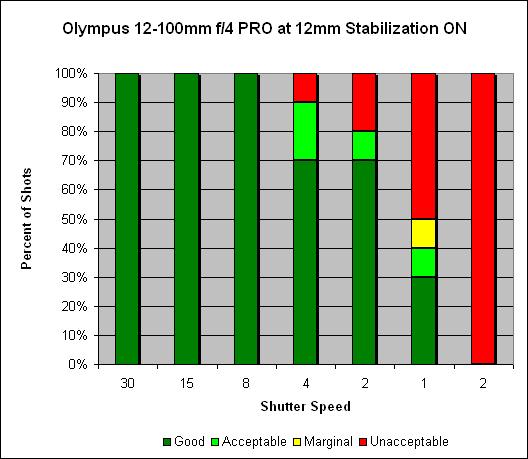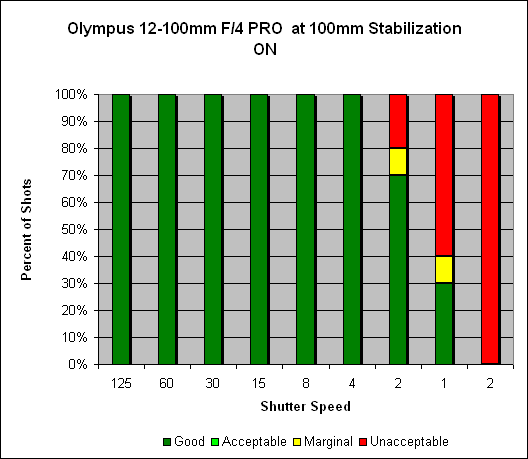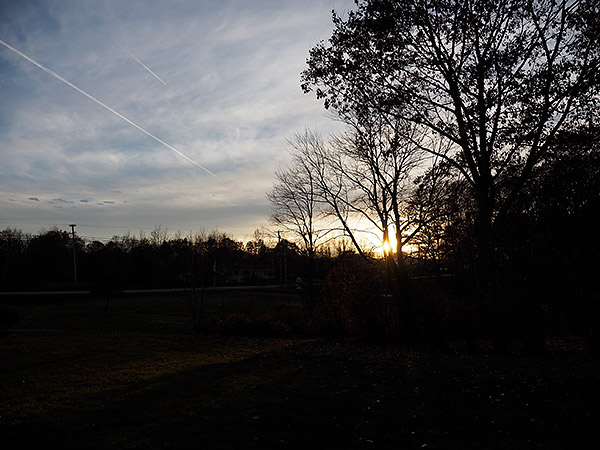| 12-100mm |
$1,200 average price |
|---|---|
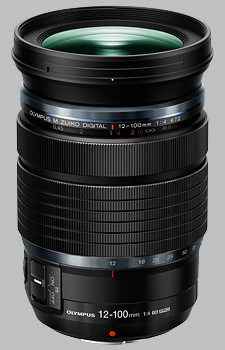
|
|
Your purchases support this site
Buy the Olympus 12-100mm f/4 IS Pro M.Zuiko Digital ED
Olympus 12-100mm f/4 IS Pro Review
by William Brawley
Posted: April 3, 2017
Updates:
11/16/2016: First Impressions
08/18/2017: Photo Essay with E-M1 Mark II
Introduced back in September 2016 alongside the OM-D E-M1 Mark II, Olympus unveiled one of the newest members of their Zuiko Pro family of professional-grade lenses, the 12-100mm f/4 IS Pro. This extremely versatile zoom lens trades the brighter f/2.8 aperture of its shorter cousins, the 12-40mm f/2.8 and 40-150mm f/2.8, for a constant f/4 design in an easy-to-carry, all-in-one solution spanning a 24-200mm equivalent focal length range, and with built-in optical image stabilization to boot.
Olympus has been on a serious tear recently, releasing a number of highly-praised lenses, especially with regards to their growing Zuiko Pro series. In fact, most of the Zuiko Pro lenses have earned some kind of award in all of our recent Camera of the Year Awards dating back to 2013.
As you may already know, we published a Hands-On Look at this lens back in November 2016. Based on this real-world test, as well as putting a copy of the lens to use during our Olympus E-M1 Mark II Field Test, we had very high hopes once this lens hit our testing lab.
So, does the Olympus 12-100mm f/4 IS Pro hit the high marks alongside their other Zuiko Pro lenses? Read on to find out…
If you had any concerns that this all-in-one 24-200mm eq. zoom lens would need to sacrifice sharpness for versatility, worry not; the Olympus 12-100mm lens is extremely sharp. Even wide-open and at all focal lengths, the Olympus 12-100 offers fantastic sharpness across the entire frame. In our testing, we saw very little variation in sharpness at the center compared to the corners. Stopping down does little to increase sharpness, as the lens is pretty much as sharp as it can get wide open.
That being said, we do see a subtle decrease in measurable sharpness out at 100mm, with a very slight softness in the corners at f/4. Stopping down to f/5.6 will sharpen the corners back up, though. Overall, 100mm is not significantly softer than the other tested focal lengths by any means, though; just very minor corner softness.
As with most lenses, we do see some diffraction-related softness creep in as you stop down to the narrower apertures. In the case of the Olympus 12-100mm, we start to measure a drop in sharpness around the time you get to f/11, though the dip in sharpness is still quite minor. The softness is more noticeable once you get past that point, mainly between f/16-f/22.
As we saw with the Olympus 12-40mm f/2.8 Pro, the amount of chromatic aberration varied slightly depending on the focal length. As before, CA is generally very well-controlled though. Between 12-25mm, the average CA stays essentially constant throughout the aperture range, hovering around 300ths of a percent of frame height. Between 35-70mm, we see a similar amount of CA at f/4, but stopping down a bit will decrease the average CA slightly. At 100mm, CA is very, very low and remains consistently minimal throughout the aperture range.
Vignetting is quite minimal, though present to some degree at all focal lengths. For most focal lengths, except 12mm and 100mm, vignetting is extremely low -- under 0.25EVs -- throughout the lens' entire aperture range. At 50-70mm, we measured a slight increase in vignetting wide-open, but nothing serious. At 100mm, though, we see a bit more vignetting at f/4, but, again, to a minor degree overall and still well under 0.5EVs of light fall-off; stopping down to f/5.6 and beyond, vignetting at 100mm falls in-line with shorter focal lengths at under 0.25EVs.
The one outlier is 12mm. Given the wide-angle focal length, it's not totally unexpected to see some vignetting. The 12-100mm displays a bit over 0.5EVs of light fall-off at f/4, which then gradually decreases in strength as you stop down towards f/11. Past f/11, we measured a slight increase in vignetting towards f/16, but then another dip down at f/22. Throughout the entire aperture range, 12mm displays more vignetting overall compared to the other focal lengths.
The Olympus 12-100mm lens is quite good at controlling distortion, especially around 18mm and longer. The corners at 12mm, on the other hand, display the strongest barrel distortion, though not a severe degree by any means; it still averages under +0.5%. Once zoomed to 18mm and longer, the distortion level is rather negligible on average, hovering right around the zero mark from 18-35mm. Past that, there's an ever-so-slight increase in average barrel distortion. However, at the extremes, 25-100mm display a bit of pincushion distortion, but again, to a fairly minor amount; well under -0.5%.
The Olympus 12-100mm f/4 IS Pro offers very fast autofocus, both with Olympus' contrast-detect cameras and with hybrid PDAF models like the new E-M1 Mark II. The electrical AF system is super-quick, taking well under a second to rack from minimum to infinity focus. In the field, autofocus feels nearly instantaneous, at both wide angle and full telephoto.
Like most recent Olympus lenses, the new 12-100mm features Olympus' MSC ("Movie & Still Compatible") focusing system, for full-time AF in both stills and video that's also quiet so as not to introduce focusing noises in video recordings. The MSC system does away with a geared system for moving the lens elements when focusing, which can cause unwanted noise. Instead, it uses a linear motor drive system for fast actuation. Coupled with a lens configuration where only two cemented lens elements are moved to adjust focus, the Olympus 12-100mm f/4 IS Pro focuses quickly, smoothly and very quietly.
Manual focusing is also available with this lens, both as full manual focus as well as full-time manual focus override while AF is enabled. When using Olympus cameras, you can set the camera to "S-AF+MF," and while half-pressing the shutter button and achieving AF, you can then rotate the focus ring and make manual focus adjustments. This also works with Panasonic cameras as well, when "AF+MF" is enabled.
For full-time manual focusing, the 12-100 has Olympus' characteristic focusing "clutch," whereby you slide the focus ring back to disable AF (and displays focus markings). It's a rather handy feature, but one that can throw you off-guard if you're not aware of it. The ring can be easily bumped and slid back to the MF position accidentally. You can disable the MF clutch mechanism altogether electronically using certain compatible Olympus OM-D cameras, at which point the clutch switch is disabled regardless of its position, leaving the lens in AF mode (MF can then still be enabled, just via the menu or Super Control Panel on the camera).
Though not designed for true 1:1 macro photography, the Olympus 12-100mm provides quite impressive close-focusing capabilities, with a minimum focusing distance of just 0.15m (0.49 ft) and a maximum shooting magnification of 0.6x (35mm equivalent) at 12mm. At the telephoto end, it offers up to 0.42x eq. magnification with a close-focusing distance of 0.45 m (1.48 ft).
The 12-100mm is the second Zuiko Pro lens to offer built-in optical image stabilization after the 300mm f/4 IS Pro. By itself, the 12-100mm offers a claimed 5-stops of stabilization, however, when paired with the E-M1 Mark II, this "Sync I.S." system is said to offer a whopping 6.5 stops of correction.
In our lab testing, the image stabilization of the 12-100mm displayed excellent performance at full telephoto, with an impressive increase in the keeper-rate with Sync I.S. using the E-M1 Mark II.
At 12mm, given the shorter focal length, I.S. is not as necessary, but the 12-100mm still offers great stabilization. Our lens technician Rob has quite the steady hand to begin with and, as you can see from our 12mm graph below, he only managed about a 40-50% keeper rate of "Good" or "Acceptable" shots with I.S. off at 1/4s exposure time. However, with I.S. enabled, that shutter speed's keeper rate jumped up to 90%. He even managed a 30-40% "Good" or "Acceptable" keeper rate down to a full 1-second shutter speed!
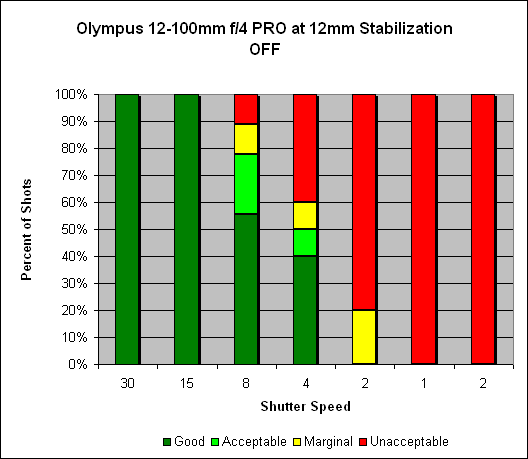 |
| Mouse over this chart to show results with IS activated. |
More impressively, at 100mm, the 12-100mm displays fantastic stabilization performance. As you can see in the following graph, Rob managed a mere 10% keeper rate for "Acceptable" shots at 1/15s with stabilization disabled, which is an extremely slow shutter speed to be using at 100mm (200mm eq.). With Sync I.S. enabled, however, Rob not only managed a 100% keeper rate at 1/15s, but also 100% all the way down to 1/4s. The lens also managed to hit a 30% "Good" keeper rate at 1-second!
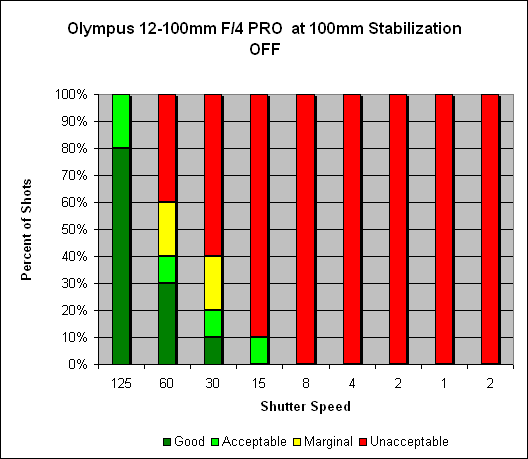 |
| Mouse over this chart to show results with IS activated. |
IS systems tend to provide more benefit to less-stable shooters than very steady ones, so most users will see the same or greater amounts of shake reduction as we measured here. You can read more about our IS test methodology here: SLRgear IS Test Methodology, v2.
Build Quality and Handling
As with other Zuiko Pro lenses, the new Olympus 12-100mm lens is built to very high standards, with the same sleek, black metal construction and robust weather sealing. Like its other Pro siblings, the 12-100mm is fully splashproof, dustproof and freezeproof down 14°F (-10°C). It's not fully submersible in water, however.
Size-wise, the 12-100mm is surprisingly compact and lightweight for all the versatility it offers. At about 5 inches long and 3 inches in diameter, it's a bit larger and thicker than the 12-40mm f/2.8, but not nearly as long as the 40-150mm f/2.8. In the hand, the lens definitely has a nice, solid heft to it, but it's not overly bulky, making it easy to carry around all day.
Mounting it to an OM-D camera, like the E-M1 II with its DSLR-like handgrip, the 12-100mm balances really well, both at 12mm and when zoomed to 100mm, since the lens extends by about two inches at full telephoto. On smaller or thinner bodies, such as the E-M5 Mark II, as our field tester Jeremy Gray noted, the lens can feel a bit front-heavy, though not excessively so.
The front element does not extend nor does it rotate during focusing (or zooming), making accessories such as circular polarizers easy to use with this lens. For screw-on filters, the Olympus 12-100mm has 72mm threads. The petal-shaped lens hood locks onto the front of the lens, bayonet-style and adds only about an inch of extra length and a bit of extra width. The hood moves with the barrel as it extends during zooming.
Regarding the physical details, the Olympus 12-100, unsurprisingly, shares many similarities with other Zuiko Pro zoom lenses. The centrally placed zoom ring is about a full inch wide with metal ribbing for an easy grip. It rotates very smoothly yet has a nice resistance to it, which is stiff enough that it definitely takes two fingers to rotate. The plus side is that the zoom action is firm enough that lens creep shouldn't be an issue.
Out beyond the zoom ring sits the thinner focusing ring with its pull-back clutch design. Pulling the focusing ring back towards you engages manual focus and reveals a focusing distance scale. Like other Zuiko MFT lenses, the focusing system is electronically controlled, with no mechanical linkage between the focus ring and the focusing elements. As such, while in AF position, the focusing ring on 12-100mm rotates freely without stops. However, when in the MF position, there are hard stops slightly beyond minimum and infinity focus distances.
In terms of its optical construction, the Olympus 12-100mm is comprised of 17 elements in 11 groups, including 1 Dual-Sided Aspherical, 3 aspherical, 5 ED lenses, 1 High-Refractive Index element and 2 Super High-Refractive Index elements. The lens also incorporates "Z Coating Nano," Olympus' advanced nano-particle lens coating technology that helps reduce ghosting and flare.
Like other Zuiko Pro lenses, the 12-100mm offers a programmable "L-Fn" button near the lens mount on the left side. This Lens Function button can be configured using compatible Olympus cameras to set various options -- and options not even related to the lens itself. You can program it to toggle adjustments such as white balance or RAW, but it can also be set as an AF-stop button. The placement is convenient as it's right near or under your thumb when using the proper camera holding technique to support the lens in your hand. (Note: The L-Fn button won't function with Panasonic cameras, although you can mount this lens to those cameras.)
Above the L-Fn button, the 12-100mm also includes an On/Off switch for Image Stabilization.
Alternatives
So far, the Olympus 12-100mm f/4 IS Pro is a one-of-a-kind lens for Micro Four Thirds shooters, as there's no other lens yet that offers the same combination of features and focal length versatility. The most appropriate alternative would be the Olympus 12-40mm f/2.8 Pro. This slightly smaller and less expensive (MSRP $1000; street price ~$899) zoom lens offers a similar level of optical performance with excellent sharpness, yet is not as versatile with only a 24-80mm-equivalent focal length range. It also does not offer optical image stabilization, however with Olympus cameras offering sensor-shift I.S., this is less of an issue. What you do gain, however, is a constant f/2.8 aperture. So, if you find yourself needing better low-light shooting capabilities, the 12-40mm f/2.8 might be a better option.
Another alternative, for those not really needing wide-angle focal lengths, would be the Olympus 40-150mm f/2.8 Pro lens. Like with the 12-40mm f/2.8, you trade-off some versatility and that "all-in-one" factor compared to the 12-100mm, but you add some extra telephoto reach as well as the extra light-gathering performance and subject isolation with an f/2.8 aperture. And again, no optical I.S. in the 40-150mm.
If you don't mind hopping the aisle over to Panasonic, they too have their "f/2.8 pair" of zooms, the 12-35mm f/2.8 O.I.S. and 35-100mm f/2.8 O.I.S, and both lenses come in at relatively similar price points compared to their Olympus counterparts. As before, you gain f/2.8 apertures for better low-light shooting, but you lose the single-lens convenience of the 12-100mm f/4 while covering the same 12-100mm range.
Conclusion
Olympus continues to crank out stunning lenses. The 12-100mm f/4 IS Pro is yet another remarkable lens for their professional line of lenses. The Olympus Zuiko Pro family now has a smattering of primes as well as a trio of f/2.8 zooms, but now the 12-100mm squeezes into the lineup, aiming at those MFT photographers wanting "Pro" image quality, build quality and performance, but in an all-in-one package.
Optically, the 12-100mm f/4 IS Pro is excellent, with tack-sharp images across its entire zoom range, even wide-open -- that's a really tough feat, and often a point of compromise for other long-zoom interchangeable lenses of the "travel zoom" category. Other optical qualities are also top-notch, and the rugged build quality is classic "Zuiko Pro." At around $1,300, however, the 12-100mm f/4 is a bit on the pricey side.
If you're shooting with the Micro Four Thirds system and want a top-notch single lens setup, perhaps for traveling, hiking, or just keeping your camera bag's weight at a minimum, the 12-100mm f/4 IS Pro is that lens. Its versatility and quality make it a winner for pretty much whatever you want to throw at it.
• • •
GALLERY IMAGES
• • •
Product Photos
 |  |  |  |  |  |
Sample Photos
The VFA target should give you a good idea of sharpness in the center and corners, as well as some idea of the extent of barrel or pincushion distortion and chromatic aberration, while the Still Life subject may help in judging contrast and color. We shoot both images using the default JPEG settings and manual white balance of our test bodies, so the images should be quite consistent from lens to lens.
As appropriate, we shoot these with both full-frame and sub-frame bodies, at a range of focal lengths, and at both maximum aperture and ƒ/8. For the ''VFA'' target (the viewfinder accuracy target from Imaging Resource), we also provide sample crops from the center and upper-left corner of each shot, so you can quickly get a sense of relative sharpness, without having to download and inspect the full-res images. To avoid space limitations with the layout of our review pages, indexes to the test shots launch in separate windows.
• • •
Shooting with the Olympus 12-100mm f/4 IS Pro
This versatile zoom lens is excellent across the board
by Jeremy Gray | Posted 11/16/2016
Olympus 12-100mm f/4 IS Pro at 12mm (24mm equiv.), f/4.5, 1/320s, ISO 200. Click for full-size image. |
The Olympus 12-100mm f/4 IS Pro lens is a brand-new wide-to-telephoto zoom lens that offers a 35mm equivalent focal length of 24-200mm, which is a very versatile and useful range. Additionally, the 12-100mm achieves this flexibility while maintaining a constant f/4 aperture. For right around US$1,300, you get a very sharp, reliable, weather-sealed lens.
When I first picked up the 12-100mm f/4 lens, it was immediately evident that I was using a pro-level lens. It has excellent build quality, including hermetic sealing in a dozen locations. The dust-proof, splash-proof and freeze-proof lens has a metal construction that felt solid in my hands.
Regarding the zoom ring, I found it to have a good amount of resistance. You won't accidentally move it, but it doesn't take excessive effort to rotate either. You can go from 12mm to 100mm in less than a one-quarter turn and the ring is marked at 12, 18, 25, 35, 50, 70 and 100mm focal lengths. The focal lengths are marked in white on silver, which can be somewhat difficult to see in certain lighting conditions due to reflections.
The focus ring, which is near the end of the lens barrel, rotates very smoothly. There's a focus scale visible when you pull the ring toward the camera body, putting the lens into manual focus mode. Additionally, the focus ring has built-in stops when the manual focus clutch is pulled, whereas you can rotate it indefinitely when it is in its AF-mode position.
I tested the 19.8-ounce (561 grams) optic on the E-M5 Mark II camera body, and the lens felt a bit front-heavy in that combination. It wasn't bad, but this is not a particularly small lens. However, given its focal length and aperture, it is pretty lightweight. The lens is 4.59 x 3.05 inches (116.5 x 77.5 millimeters) and has a 72mm filter thread. For filter users, the front element doesn't rotate as you change focal length, which is great. Speaking of focal length and the lens, however, it does gain about an inch and a half of total length when extended from 12mm to 100mm.
Despite being somewhat compact for its optical and physical qualities, the 12-100mm f/4 has built-in image stabilization which provides up to 5 stops of correction on its own. However, when paired with the new E-M1 Mark II's 5-axis sync image stabilization, the lens+camera combo can provide up to an impressive 6.5 stops of correction. In my experience using the optic with the E-M5 Mark II, image stabilization worked well, even when at the telephoto end of the focal length range.
Overall, the Olympus 12-100mm f/4 IS Pro lens has excellent physical characteristics, features and handling. The lens’ construction is robust, weather-sealed and comfortable in the hands.
The optical formula for the 12-100mm lens is quite impressive. It features 17 elements in 11 groups, including: one dual-sided aspherical, three aspherical, five ED, one HR and 2 Super HR elements. It also includes Z Coating Nano. Tthis is a sharp lens across the board based on my real-world experience.
Even at its telephoto limit of 100mm (200mm equivalent), the Olympus 12-100mm performs very well. Sometimes the performance of zoom lenses falls off quite dramatically at either extreme, but that's not the case with the Olympus 12-100mm, at least not to my eye. The same story holds true at 12mm, where the Olympus performs well. There is a slight issue with vignetting, particularly at 12mm, however, which can be partially sorted out by stopping the lens down to around f/8. At 100mm, light falloff is a minor issue as well; similarly, it is reduced by stopping down.
I had no issues with lens flare with the 12-100mm f/4 at any focal length, which I found very impressive. Although in high-contrast scenes, such as backlit scenes, there was evidence of aberrations, particularly when shooting wide open. The issue was more noticeable at the wider end of the lens, and at the telephoto end there was chromatic aberration as well. It wasn't extreme nor was it difficult to correct during post-processing. In fact, JPEG images didn't display the issue much at all with default camera settings.
Olympus 12-100mm f/4 IS Pro at 100mm (200mm equiv.), f/4, 1/125s, ISO 800. Click for full-size image. |
In real-world use, the 12-100mm f/4 proved to be as versatile as it is optically impressive. The ability to cover the 24-200mm equivalent focal length range with a constant aperture is very useful. Not only that, but to do so with a lens that is reasonably compact and lightweight makes me believe that the 12-100mm f/4 Pro optic could be an excellent lens for travel photographers who demand the best in image quality.
Although not a macro lens, the Olympus 12-100mm f/4 can focus quite closely. At 12mm, the lens can focus as closely as 0.49 feet (15 centimeters), which is a 35mm-equivalent magnification of 0.6x. At the telephoto end of the lens, it can still offer up to 0.42x eq. magnification, which isn't bad.
I didn't discuss the lens' function button in the physical characteristics section, but it's a pretty neat feature that has some good programmable options. You can customize the button to use focus peaking, AF Stop and Magnify. The button is located in a convenient place on the lens barrel, although it does have a somewhat odd feel to it that I didn't particularly like. The button action is quite squishy and imprecise, and doesn't depress well from many angles. Also, at times, you feel like you've pressed it in enough to trigger it, but then it doesn't and you have to press it even further.
Bokeh is a very subjective quality of a lens. What one person thinks is good bokeh, another photographer may consider to be bad for any number of reasons. With that said, in my opinion, the Olympus 12-100mm f/4 produces pleasing bokeh and renders the background quite well. It isn't going to create the silky smooth backgrounds of a faster and/or longer lens, but provided you can create some distance between your subject and the background, it can do some impressive work at 100mm. Out of focus areas are rendered into quite pleasing circles despite the lens having only seven diaphragm blades.
Autofocus performance depends on the camera as well as the lens, but when shooting the Olympus 12-100mm f/4 with the E-M5 Mark II body, it offered fast, dependable autofocus performance. Beyond being speedy, it's also quiet, which is always nice.
As I discussed above, focus sounds are basically nonexistent with the 12-100mm lens. Additionally, when shooting video, you can zoom the lens without too much distracting noise being picked up by the microphone. If you'd like to manually focus, the focus ring is quite smooth and works well. This strikes me as a solid option for shooting video on your Micro Four Thirds camera, especially considering its image stabilization, which makes it easy to use handheld.
Olympus 12-100mm f/4 IS Pro Zoom & Focus Test 1920 x 1080, 60fps, ISO 200 Download Original (109.9 MB .MOV File) |
- Excellent build-quality: Weather-resistant, great rings, feels good in the hands
- Very good optical quality across the board
- Surprisingly good macro capabilities
- Versatile focal length range
- A bit heavy when mounted on smaller camera bodies
- Lens function button has a strange feel when pressed
- Focus ring clutch is easy to accidentally pull
Olympus 12-100mm f/4 IS Pro at 75mm (150mm equiv.), f/5, 1/320s, ISO 200. This image has been modified. Click for full-size image. |
Overall, the Olympus 12-100mm f/4 IS Pro lens is a very good option for a wide array of shooting situations. This is the travel zoom that Micro Four Thirds shooters have been waiting for. Its 24-200mm equivalent focal length range and constant f/4 aperture make it well-suited for landscapes, portraits and much more. If you're patient and lucky, it can even work well as a wildlife lens (although certainly not as well as something like the longer Olympus 300mm f/4 IS Pro lens would). It offers quick, accurate autofocus; sharp images at every focal length; and high-end build quality. If you're looking for a highly-versatile, general-purpose zoom lens for your Micro Four Thirds camera, the Olympus 12-100mm f/4 warrants a long look. At US$1,300, it's not cheap, but you absolutely get what you pay for and then some.
• • • • •
Photo Essay with E-M1 Mark II
Olympus 12-100mm f/4 IS Pro M.Zuiko Digital ED
Your purchases support this site
Micro Four Thirds - Black
Olympus 12-100mm f/4 IS Pro M.Zuiko Digital ED User Reviews
-
Sharp, Great IS, Very wide zoom range
I've only had this lens for about 3 weeks - and I do not do any type of testing other than actually use the lens in real life situations - and so far I am very impressed. The range from wide angle to telephoto zoom is extremely handy. Normally, in order to have this type of zoom range, lenses have been optically compromised. That Olympus was able to produce this lens and have the sharpness and overall quality be so good thru the entire zoom range is remarkable. And the IS - combined with the Olympus IBIS on the E-M1 - is really an eye opener. I took a few hand held shots with a 1 to 2 second exposure and they were sharp. I really thought similar comments I had read about the IS in other reviews was just hype - but it is real! Probably the best lens I have ever owned - by far!
reviewed August 3rd, 2017 -
Sharp, even wide open. IS is very good, even on Lumix bodies. Close focusing makes for a very versatile travel lens. OOF areas is very smooth.Larger than some may want, though smaller than the 12-35/2.8 and 35-100/2.8 combo.
There's not really a lot to say that hasn't been said many time over concerning the quality of this lens.
reviewed June 12th, 2017 (purchased for $1,299)
Almost all reviewers are mounting it on the E-M1 II which is understandable, but I don't have that body to shoot with. I shoot with the Panasonic GX7 and the GX85. The GX7 has a limited 2-axis IBIS while the GX85 has a 5-axis IBIS. Mounting the 12-100 on either of these bodies results in the IBIS options being grayed out in the camera menus, leaving only the lens IS active. The lens IS is considerably better than the IBIS of the GX7 and has given that camera a new lease on life. I have the J.B. Camera Designs grip on each of my camera bodies which do aid in using a larger lens like the 12-100.
I travel professionally and carry one of the Lumix bodies, the Panny 7-14 with the 12-100 in a small Tenba bag, making for a wonderfully small, quality kit. I have fast primes when I need the speed, but otherwise, the 12-100 @f/4 covers such a wide range of circumstances.
If you are looking for the best travel lens - this is the one. Don't think you have to have the E-M1 II to use it! -
Pro build quality Very Sharp Great rendition VersatilityNone yet
I use all the Olympus Pro's and Primes (except the 25mm f/1.2) and have really been looking forward to trying this lens because when I'm hiking in the hills or travelling I don't like to carry a load of gear. I changed to Olympus because of the weatherproof construction and light weight make the whole system much more usable and all round less hassle. I have been more than happy with the change and I have always been amazed by the quality of Oly a Pany glass.
reviewed November 23rd, 2016 (purchased for $1,367)
First outing, I put the 12-100 on my favourite travel camera the EM5 mk2. As soon as I started shooting I knew this lens was something special and by the time I had looked at the shots in lightroom I knew I had found my dream travel lens.
Sharp - Oh yes, very sharp across the frame, even shooting wide open.
Colour rendition - For me this is really the most important factor, it simply takes the most gorgeous images. Seeing is believing.
Background Blur - Well, MFT is different from a larger sensor and need different technique, use longer focal length, get in closer, open up the aperture wide and just watch the background disappear. Just like using the 75mm f/1.8 for portraits. It works brilliantly and the zoom range allows so much framing versatility.
Image stabiliser - With the sync- IS using lens IS and Olympus body IBIS together it's like having a built in tripod.
My travel kit - The 12-100 f/4 with the tiny Oly 9-18 f/4 - 5.6 and the Panasonic 20mm f/1.7 prime. Thats it, thats all the kit I would take any trip now, such is the versatility and quality of this lens.
Value for money - Well, its not cheap, but it is very very good indeed and when you consider just how versatile it is covering a focal range from wide to med telephoto it represents very good value for money. Its definitely a professional or serious enthusiasts lens and anybody who buys it will not be disappointed.
I am loving it, if your photo life needs a lift then I highly recommend you try this lens. Happy shooting.




